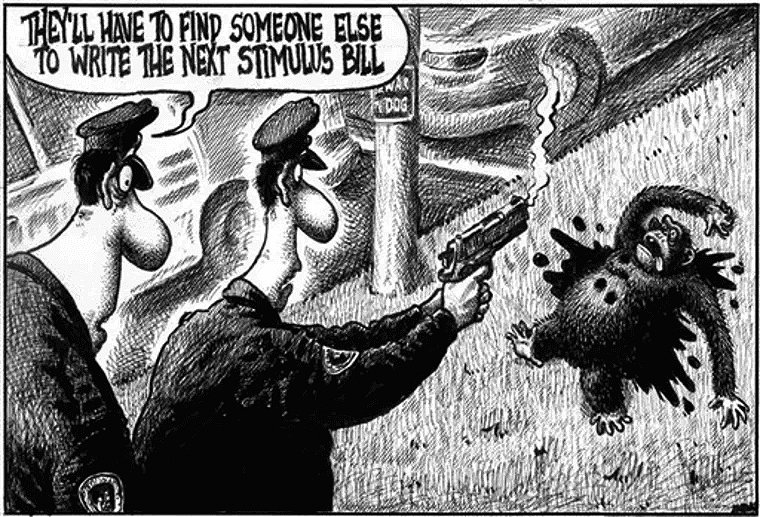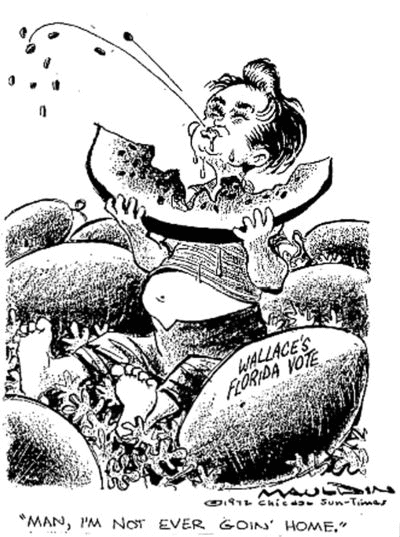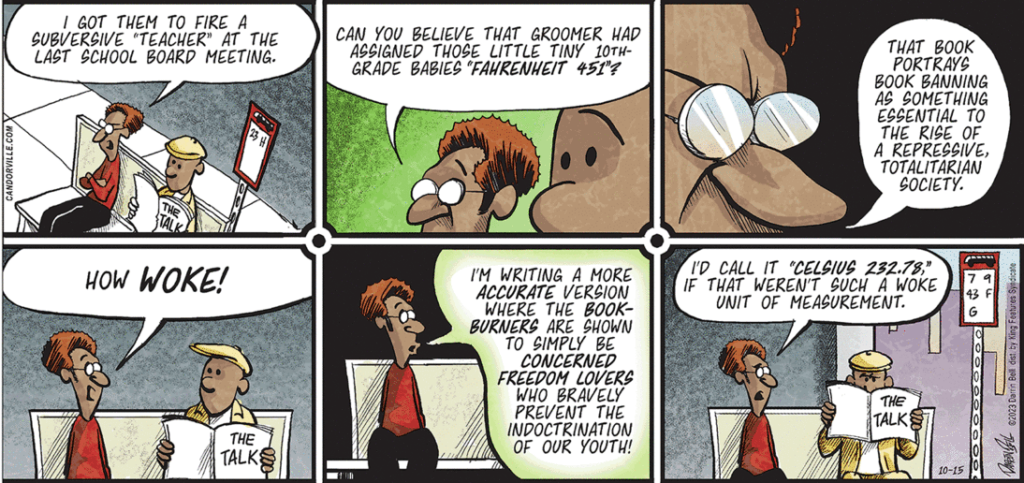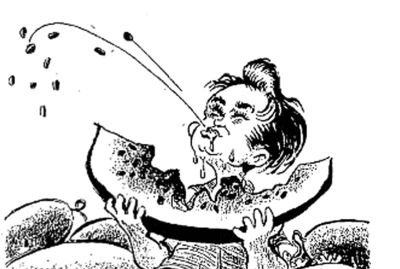
The issue of Steve Bell‘s spiked cartoon of Netanyahu continues to roil social media, at least in editorial cartooning circles, and the topic was recently amplified when the Aspen Times apologized for running a Dave Granlund cartoon that some readers misinterpreted.
The problem isn’t new, and this Sean Delonas cartoon went famously off the rails for the NY Post in 2009. It combined two news stories: One about a chimp, kept as a pet, which became violent and had to be shot by police after seriously mauling a woman. The other was Barack Obama’s signing of a stimulus bill.
The Post, having approved and published the piece, stood by it, though they’d have also gotten credit had they apologized for their poor judgment. But they didn’t take the coward’s way out, throwing up their hands and blaming Delonas for a cartoon they had agreed to run.
His intention was to insult the president. That’s what he did and it’s within the scope of what editorial cartoonists are supposed to do. And NY Post readers expect to see liberal politicians insulted on the paper’s editorial page, so that’s not an issue.
The issue is that you can’t equate monkeys and African Americans unless you intend a racist insult, which Delonas reportedly did not.
Didn’t matter: Readers were insulted.
It’s an issue of understand the tools in your toolbox; You don’t pound nails with a pipe wrench. A good craftsman knows his tools and uses them appropriately.

For example, when George Wallace scored in the Florida primary in 1972, Bill Mauldin drew him as a happy, barefoot Southern country boy celebrating in a watermelon patch. Insulting? Yes.
But if George Wallace were Black, Mauldin could not have used watermelons as a prop in his cartoon. Any competent cartoonist knows that, whatever his intentions, whatever is in his heart, watermelon jokes are going to be taken as racist if applied to African Americans.
You have to know these things. You also have to know that, once you’ve published, you’re no longer in control of how a piece is interpreted.
It doesn’t matter what you meant. What matters is your skill in communicating your point.

Bell knew what he wanted to say: He was riffing on David Levine’s classic cartoon of Lyndon Johnson showing the scar from his gall bladder operation, but with the map of Vietnam in place of the scar.

There are several problems, aside from referencing a nearly-60 year old cartoon.
LBJ really had shown off his scar to reporters, another of the folksy, semi-vulgar touches for which he was known. Netanyahu is hardly folksy, and any parallel between the two men is more than a stretch.
That Gaza would also leave a scar is thin broth, while more critical is that the “strangely cryptic” term “pound of flesh” readily comes to mind and is perfectly well known, even if you’ve never read “Merchant of Venice.”
His editors correctly foresaw that readers would connect the cartoon with Shakespeare’s Anti-Semitic portrait.
We don’t know whether they rejected the piece outright or offered Bell a chance to recast it, but we do know that the Guardian’s editors had recently let through a cartoon by Martin Rowson that had touched off a firestorm because people misinterpreted the caricature and some props in the piece as Anti-Semitic.
Rowson apologized for a cartoon people could misinterpret, and he served a suspension despite his intentions not being in the least Anti-Semitic. In that case, the editors behaved as if it were entirely his fault that nobody in the chain of command had spotted the potential for misinterpretation.
Imparting two morals that every cartoonist absolutely must know:
One is that intentions don’t matter. It’s up to you to express yourself in a way least likely to be misinterpreted.
The other is that good editors will protect you against any unintentional flaws that might creep into your work.
Not that good editors are any more plentiful than good cartoonists, mind you. It’s something of a miracle when they find each other.
We also don’t know whether Bell was let go from the Guardian because of that one cartoon, or because he put the newspaper’s business in the street. Nobody would have known it happened, had he not complained on social media.
However, once again, it’s not important what anyone’s intentions were. What matters is what happened.
The dogs bark, the caravan moves on.

There are, certainly, people who get things wrong at a level no artist, writer or editor can possibly avoid. Most do it out of sincere ignorance, some as a result of brainwashing and some because they’re intentionally trying to pick a fight.
You can’t avoid them all.
Darrin Bell, however, has the advantage of doing an editorial cartoon but also creating Candorville (KFS), which gives him the option of making his point over six panels rather than in one.
He still employs sarcasm here, and someone who had never seen the strip before might miss that and assume the speaker represents the artist’s voice.
But even without realizing Lemont is the strip’s protagonist, his curious looks and then angry expression at the end should provide a clue. Bell has done a good job of insulating himself against accidental misinterpretation.
And Fahrenheit 451 is a good metaphor, because, in the current political climate, there are those who intentionally seek to take offense, and that can happen at either end of the political spectrum.
The endgame depends on who you work for. In the past few years, we’ve seen one case where an on-line lynch mob cost a cartoonist his job and another in which management dug in and held tight. (Either way, it leaves scars I’m not going to re-open by being more specific.)
It’s good to be supported, but it’s also worth finding out if you’re not. As I’ve noted before, I’ve never lost a job I still wanted.
Though that attitude is easier when you’re single and your kids are all grown and gone. As I’ve also noted before, it’s just me and the dog, and she thinks sleeping in the park and eating out of Dumpsters would be a blast!
Unless you agree with her, be careful out there, and remember that nobody cares what you intended.
They see only what you did.
Make it clear. Make it count.

I have to admit that I didn’t immediately catch Steve Bell’s reference to the Levine cartoon, nor did I make the unintended connection to Shylock’s “pound of flesh.” Perhaps I was thrown off by the dialogue in the cartoon or those boxing gloves — which might as easily have been references to one of Jordan Peele’s movies or the recent Rocky sequels.
On the other hand, I’m fully expecting someone to accuse Darrin Bell of using an anti-Semitic trope in his “Blood of Innocents” cartoon over the weekend. https://darrinbell.substack.com/p/the-blood-of-innocents-and-the-inevitable
Given that the Death figure in that cartoon is clearly labeled as “Hamas” and that Palestinians (including Hamas members presumably) are also a Semitic people, such an accusation would seem foolhardy. So, yeah, probably expected but easily debunked.
I’ve argued for years that it’s an editorial cartoonist’s job to know what symbols mean and if they accidentally use a symbol that has a meaning they’re ignorant of, either there was no “accidentally” about it or they are bad at their job and shouldn’t be a cartoonist. A cartoonist isn’t someone who knows how to draw, they’re someone who knows how to graphically represent ideas and use visual metaphors. Knowing what a chimp or a watermelon or whatever else represent in different contexts is part and parcel of the job description. I can forgive an editor for missing the meaning behind a specific reference, but not the cartoonist.
My favorite part of that Candorville strip is how the guy refers to Sophomores as “10th grade babies”
Because everyone knows children are innocent little waifs that need to be protected at all times… until they turn 18 and are thrown to the curb.
Or they’re innocent little waifs when it fits one political agenda and full grown adults when they fit another (I.e: being in any legal trouble while failing the paper bag test.)
It should be noted that Darrin Bell did a cartoon on the subject that is simple, clear and concise, showing a Hamasnik painting a target in blood with a Palestinian infant at the center.
Semiotics can be a tricky business, though. Remember when Bianca Xunise drew a Black woman in a N95 and an “I can’t breathe” t-shirt being told by an unmasked white woman to “take that silly mask off?” She got accused of racism because, if you didn’t know that the Black woman was an author insert, you could read it either way.
Mike Thompson got into a bit of hot water too, with the CAIR when the Star Tribune published a cartoon of his about an ordinance In Minneapolis permitting the audio transmission of the Muslim call to prayer. The intent of the cartoon, best as I could tell, was “what? With all the gunfire in Minneapolis, you’re going to complain that the call to prayer is too loud?” The CAIR read it as equating the call to prayer with gunfire.
Steve Bell’s cartoon is a hot mess in ways I’ve discussed on d.deggs post. Unlike Xunise and Thompson, there isn’t even clarity of message. It’s a semiotic jumble only made worse by his attempt to reference Levine.
Doesn’t the editor have to see a thumbnail of a political cartoon before the artist goes to final? Bell writes on his website that he submitted the cartoon last week. If the editor had a problem, why was it published?
The cartoon is not easy to read and I feel that there are too many visual metaphors. Your analysis is spot on.
The Guardian has ‘not renewed Steve Bell’s contract.’.
It wasn’t. Steve published in on his social media account and whined that it was rejected.